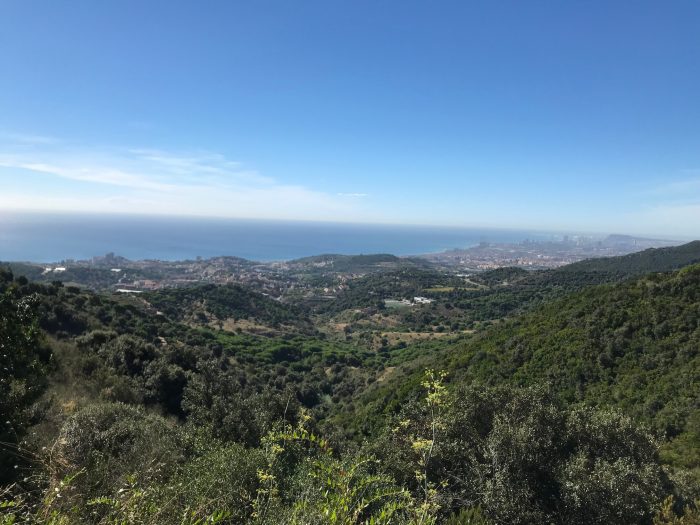“Congratulations”, the email read. “You were the first name out of the hat, and you’ve won the trip. Do you want to accept?”
I wiped the espresso off my iPad screen, having performed a spit-take that would make the Three Stooges proud.
“Tell me you’re not a Nigerian prince”, I replied.
I was now out of espresso, so I went back into the kitchen and refilled the Bialletta. It was just past 6am, and I had to jump-start my brain cells before the day’s chores of dispatching my offspring to school, dispatching boring emails to the trash bin, and dispatching annoying voicemails to the aether. Actually, all voicemails, annoying or interesting, were to suffer the same fate.
“No, this is legit”, the next email said. “You’ve won the Barcelona to Girona Gravel trip. You just need to get to Barcelona.” Some time ago, I had entered a drawing for a Thomson Bike Tours Gravel tour from Barcelona to Girona. This was an inaugural trip for Thomson, and it had been on the front of their web page for months. Thomson is known for leading high-class, challenging, and extremely well-produced cycling tours throughout Europe. Their offerings range from Belgian Spring Classics Tours to following the Tour de France, Giro d’Italia, Vuelta España, and much more.
I was reasonably sure someone flew to Barcelona daily, so that part would be easy. It was sinking in that I had just won an amazing trip, one well out of my budget and wildest dreams, and I had certain logistical issues which would have to be dealt with immediately.
“Honey, you look great this morning,” I said to my wife.
She scowled, knowing something was up. “It, uh, looks like I won a trip cycling in Spain. There’s uh, one entry, and you hate gravel cycling, but you should be excited for me.”
Her eyes narrowed a bit. “Beg pardon?”
“I entered a contest.” I enter every contest.
“I won.” I never win.
“What will we do with the kid while we’re in Spain?” She asked.
“About this ‘we’ part…” I said. “It’s a pretty challenging route. This entry is for one person. You haven’t been riding the gravel bike I built for you, what with how you have a real job and a fixed schedule and how you’re really important at work and they can’t live without you even for a minute. Because you’re important. And everyone there worships you.”
I had two simple options: sell this or sink it. “It says that the ride-along on this trip isn’t great. How about I send you to visit your brother in Honolulu?” I played my best card first.
“You should do this ride.” My wife is a smart, beautiful woman, and she knows I would have been a royal pain in the ass, sulking like a teenager if she hadn’t given permission. I could have probably sulked for months. I’m pretty immature, having been avoiding adulting for several decades, and I’m good at it. It just takes a bit of dedication.
“I’m in,” I emailed back.
It was early May, ample time to train for a week-long cycling trip. I studied the Thomson website, pored over Strava heat maps, downloaded multiple versions of Open StreetMaps, and got on my bike. Since I don’t have a gravel bike that my wife knows about, I logged as many miles as I could on that non-existent machine. I rode the Moots Ranch Rally, joined friends in Capital Forest (outside of Olympia, WA), hunted singletrack and gravel near my home, and added wife-repelling spiders to the basement (where I would keep the gravel bike, if I had one). These efforts consumed my summer.
I rode with local cronies and miscreants, and we searched out gravel rides on Vail and Beaver Creek ski areas, loops around Snowmass, and found new ways to connect rides we knew well. Miles added up, climbs accumulated, and hours whiled away as we rode on bikes that we didn’t admit to owning. During this time, discussions around the dinner table always addressed the deadly spiders that had taken over the basement, and how everyone needed to stay out of it. No one seemed to question my own immunity to deadly spiders; it was somehow assumed.

The season wore on, and I accumulated more miles than I had for several years. Along the way, I lost about 30 pounds. ‘Lost’ is probably a misnomer, as once the snow flies I may well find every missing ounce. Unlike losing a set of car keys, which is permanent, losing weight is temporary. Winter is coming, and I’ll need that flab, purely for insulative purposes. In any case, I regained a view of my feet. I had forgotten I owned a pair.
I dragged my son out for long rides, which he only complained about until he warmed up. We rolled away many 3 to 5 hour rides, challenging each other, talking, and enjoying each other’s company. He’s almost a tween, so these days are numbered, and I enjoy them all. I’m not necessarily a fan of being dropped on climbs by an 11-year-old, but I’m there to run interference with cars, after all.
He had a big summer, between road cycling, a bit of BMX racing, and riding with me, and as school started in late August, he had over 1,000 miles already logged. He got his first century in, riding on my wheel for 97 miles before telling me to “step it up” as we headed for the finish. Following proper cycling etiquette, I swung off and waved him through. Not bad for a 6th grader, but he likes cycling and rarely says “no”.
September arrived fast on the heels of June, somehow skipping July and August entirely, and I realized I didn’t have enough miles to be truly ready for a Thomson trip. Work got in the way, as often happens, and a trade show coupled with business travel ate the last rideable hours and delivered a head cold. My departure date was 10 days away, deadlines were stacked up, and my sinuses were bursting. I decided this was a good time to taper.
As if I had a choice. Work ate the hours, and my bikes scowled at me from under their cloaks of poisonous spider webs. Finally, the day came, I put my bag in the car and headed eastward towards Denver International Airport, which is located in far western Kansas. I parked in the satellite lot, which is far enough away from the terminal to actually orbit the earth, so it is well named.
My flights were as expected: delayed at the gate, delayed on the tarmac, bumpy, overcrowded, and uncomfortable. Customs at Barcelona airport was slow, with 20 booths, but only 4 booths occupied by bored officials with stamps. I made it through and headed to the hotel, peering out the windows of the cab and dreading the onset of jet lag. I had made reservations at the hotel Thomson chose for the start of the trip. Their website was very well put together, with hotel details for each night. This made adding days to the trip easy, as I had no idea where to stay.
Thomson had chosen well with the Abba Garden Hotel, located at the end of the L3 metro line and at the base of the mountains. This hotel, despite its name threatening to implant disco earworms to haunt my dreams, was a gentle buffer between the hubbub of Barcelona and the quiet of the mountains that border the northern side of the city.
I’ve lived in cities, and gritted my teeth through that existence. My hometown has a tiny population, smaller than many university dormitories, and I’ve never been happy in urban environments. I live 10 miles outside of town, preferring the quiet of the forest and lack of idling engines.
Steeling myself, I headed to the metro and dove headlong into the city. The subway system is impressive , and navigating it is surprisingly easy. Multi-day passes make it simple and affordable, and it’s the ideal way to explore Barcelona.
Gaudi rules the roost in Barcelona, and anyone with a sense of wonder can’t help but be drawn into his works. I had done a token bit of research on his work and as recommended, purchased my tickets to his works online beforehand. Even so, some attractions were sold out two days ahead, so plan well before you visit. Sagrada Familia nearly defies description (and certainly defies any attempt to capture it in photographs), and his other works have block-long lines to gain access, even with pre-purchased tickets.
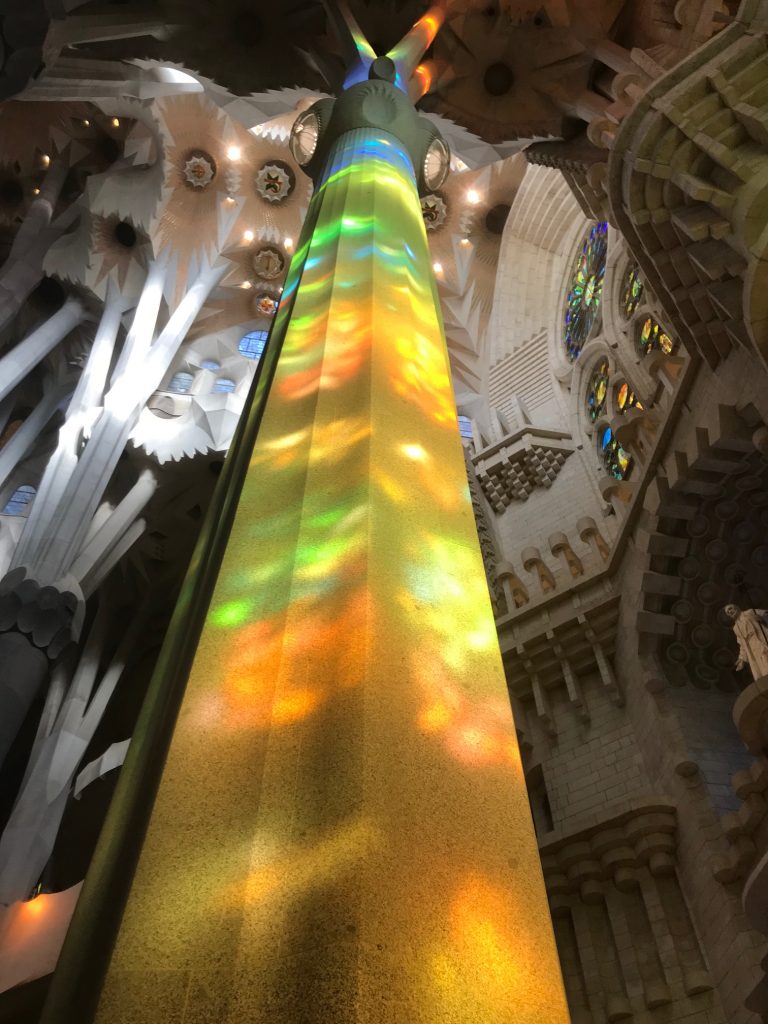
The secret discovery was the MUHBA Plaça del Rei museum just east of the cathedral in the Gothic Quarter. This underground museum exposes Roman ruins, from a laundry to a fish market and wine maker. It’s quiet, uncrowded, and unlike many archeological museums, not hotter than 10 hells, as it’s completely underground. It’s the best 7 euros I’ve spent touristing.
Naturally, Barcelona has much to offer for food, drink, nightlife, culture, and so forth. Big cities tend to do that, and have an intensity all their own. 48 hours of this intensity was plenty for me, and I maintained American hours- I’m too old for late nights at bars. Plus, at low altitudes I can put away prodigious amounts of alcohol with no side effects beyond a large bar bill. Still, it’s a nice city, and I happily walked about 20 miles in my two days exploring it.
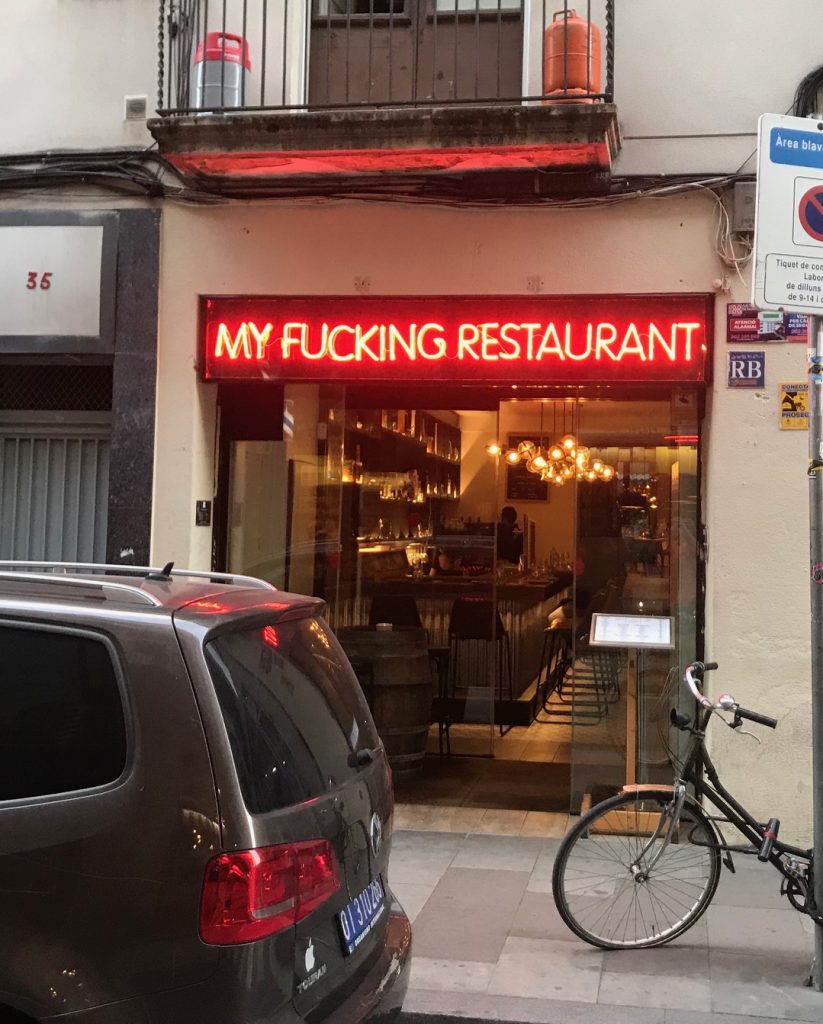
Finally, it was time to ride. Guides and guests trickled in, and setup ensued. Thompson provided bikes, in this case, the Canyon Grail (see review here). Guide/mechanic Marc installed my pedals and saddle (my ass is huge, but very sensitive, so I bring my own well-trained saddle), then I fussed with my toptube bag and Garmin mount. Other guests trickled in as their flights arrived. Some brought their own bikes: a Trek, a Norco, a 3T Exploro, a beautiful titanium Seven, and even a Grail. We had a quick meeting, ate a huge lunch, then saddled up for our shakedown cruise.
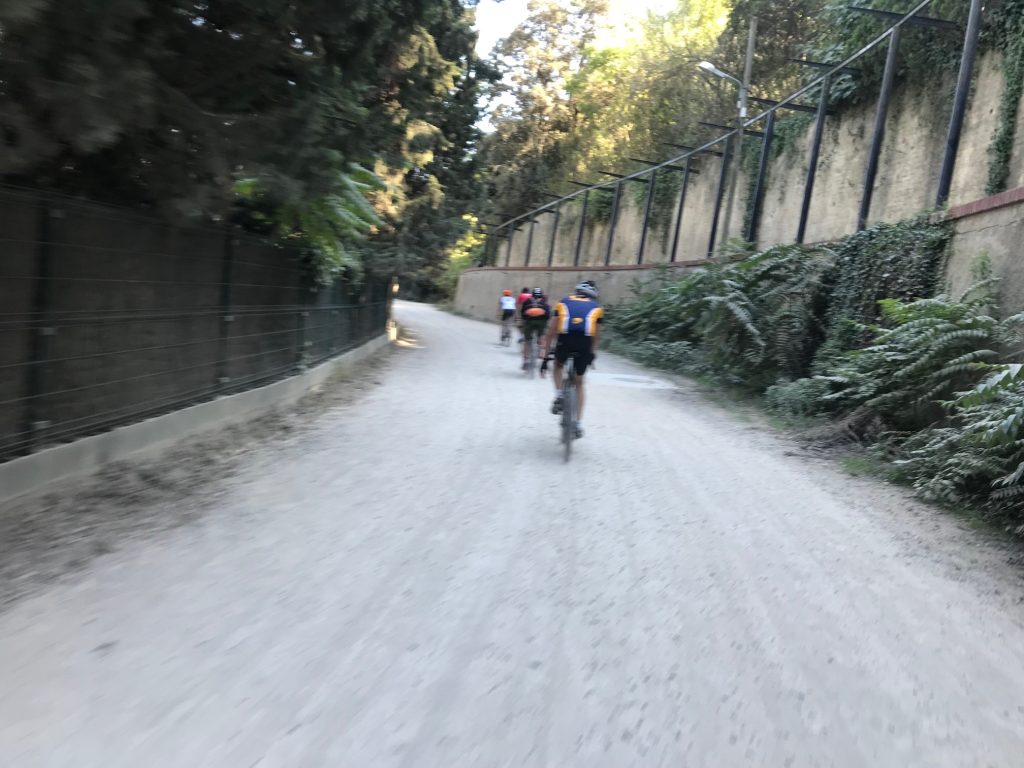
All group rides are the same: everyone hammers and no one admits it. Thomson, like all quality guides, uses the first few hours to suss out the group- who is strong (not me), who is a good climber (not me), who is a poser (me), who is dropped immediately (again, me). Riding with this group, it’s clear that I’m no climber, but when the trail pitches down, my substantial mass and descending skills put me towards the front of the group.
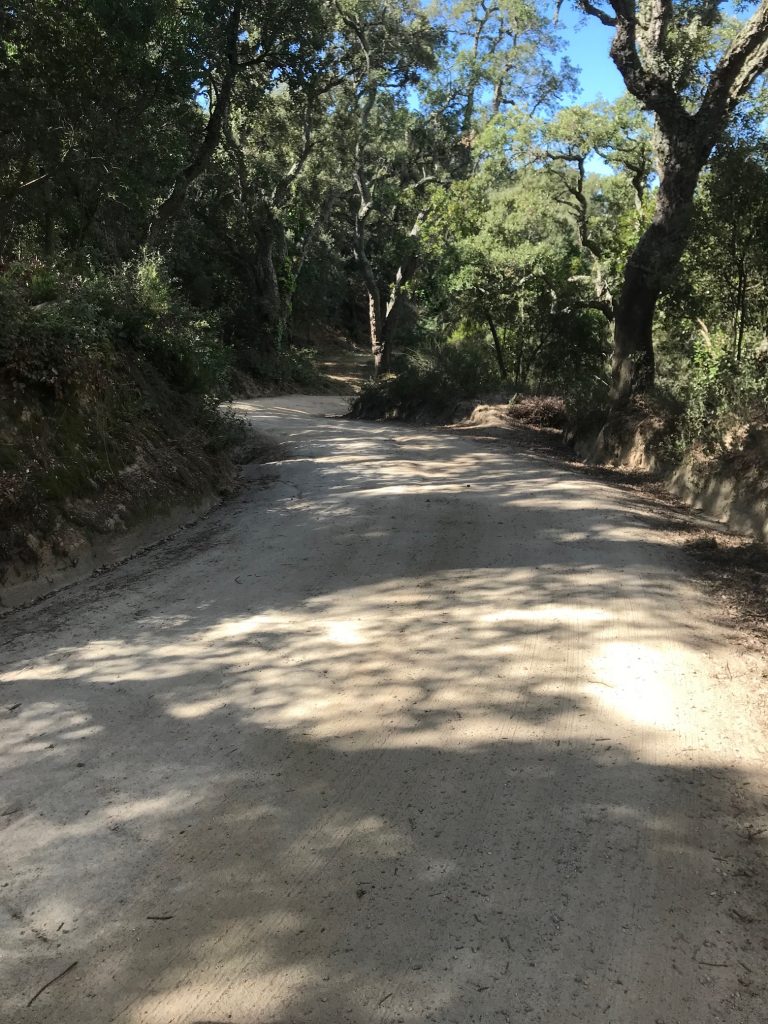
It was also clear that although I graduated high school when telephones were firmly attached to walls and computers used televisions for monitors, I was one of the youngest of the guests. Most are veterans of multiple trips with Thomson, all are strong cyclists, and some have never ridden gravel.
This summer, I’ve logged a lot of miles of drop-bar singletrack, and out of the 1500 miles of drop-bar dirt, 800 or so were on twisty singletrack trails on the edge of town, and a few have been within the bounds of control. The rest were in the realm of point-and-hope, and I’ve gotten relatively good at letting go of the brakes and somehow escaping with the majority of my skin intact. Due to this practice, as well as my ample gravity-friendly girth, when the grade tipped down, I moved to the front of the group and enjoyed the non-technical descents at a good pace. One other guest, whose climbing prowess equaled my own, joined me at the front of the group, and we rolled away from the svelte climbers, creating vast dust clouds like a two-man stampede.
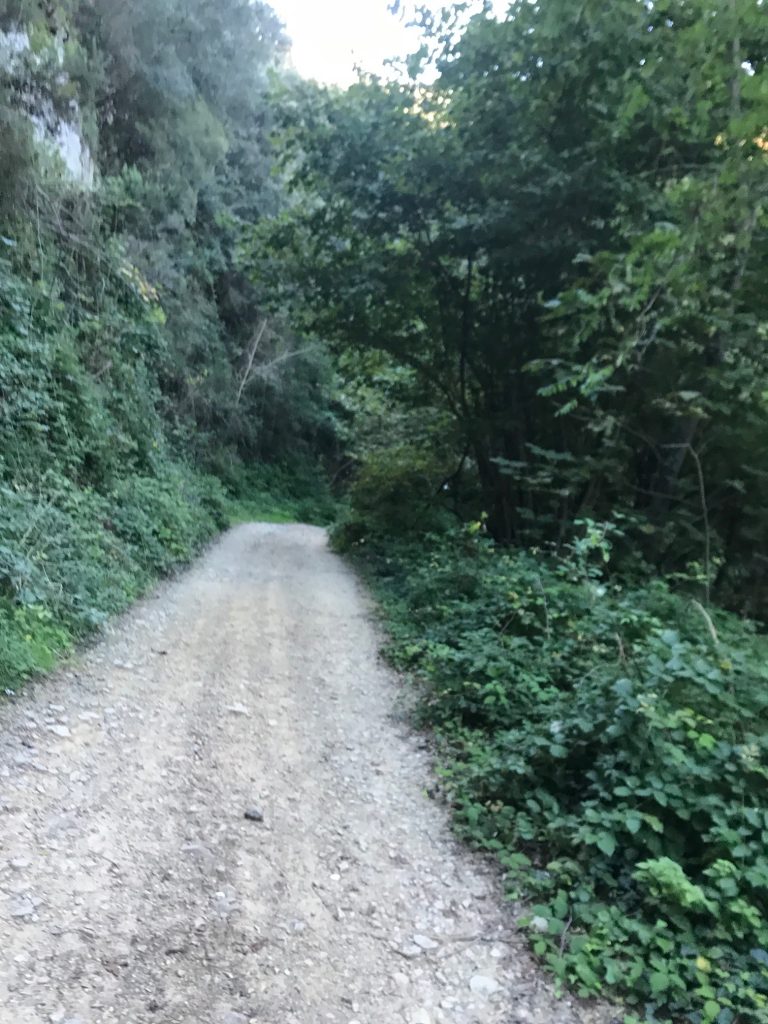
The mostly contour-line ride (with substantial climbing at the start) was a pleasure, and the views offered of Barcelona were beautiful. As it was a group ride, there was little chance to take photos due to the pace. However, glances to the south were rewarded with a broad vista of the city and Mediterranean Sea.
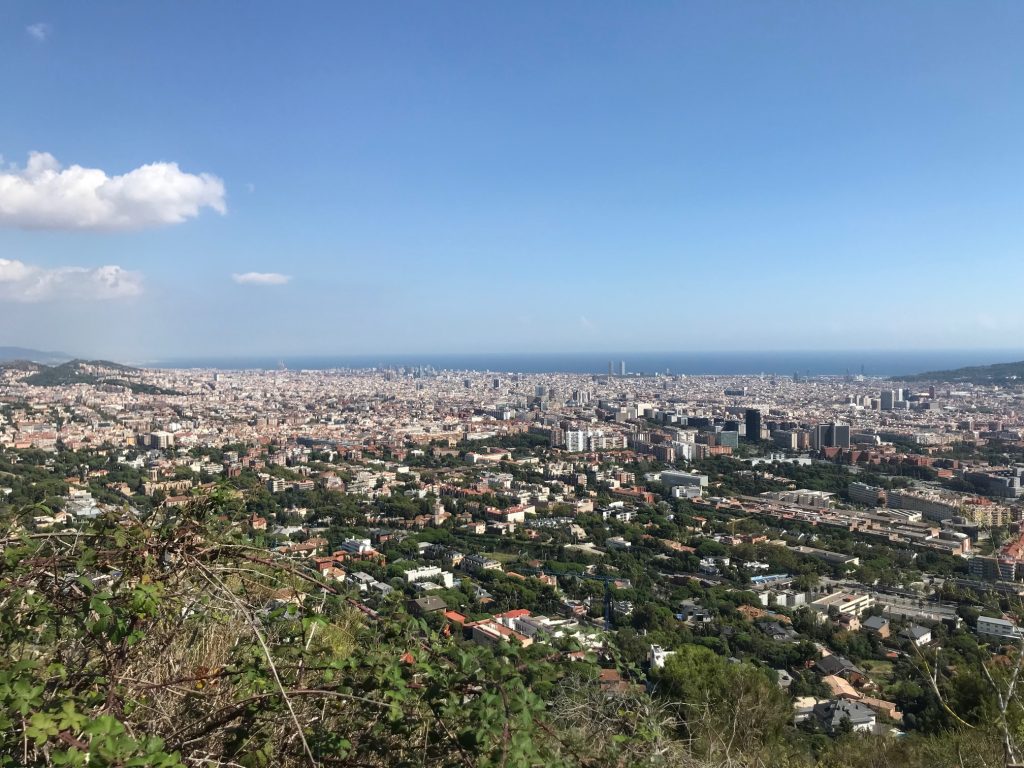
Once the ride was over, we had a few hours before the nightly briefing and dinner. With 12 guests and 5 guides, remembering names was no easy task, and I quickly forgot everyone’s name as soon as I shook their hand. Fortunately for me, 2 guides were named Sergi, so that eased the nomenclature burden slightly.
Our nightly briefings included a review of the route, updated GPS files as needed, schedule notes (time of breakfast, time to get suitcases loaded, estimated time at next hotel, next briefing, dinner, etc.). The whole schedule was presented clearly and efficiently, and if you managed to screw it up, it was your problem. I took notes, because I don’t like to be That Guy.
After breakfast on day 2, we headed out from the hotel, dodging traffic and weaving through the edges of the urban environment. Our destination was the famous Montserrat, but our approach would deviate from the standard drop-bar route, sticking to unpaved surfaces as much as possible. Within a few kilometers, we left the urban perimeter behind and reached the river bottom. The two-track road we followed meandered along the riverbank, and the dry sandy surface was well-packed, so the speed was fairly high, at least until the first flat tire.
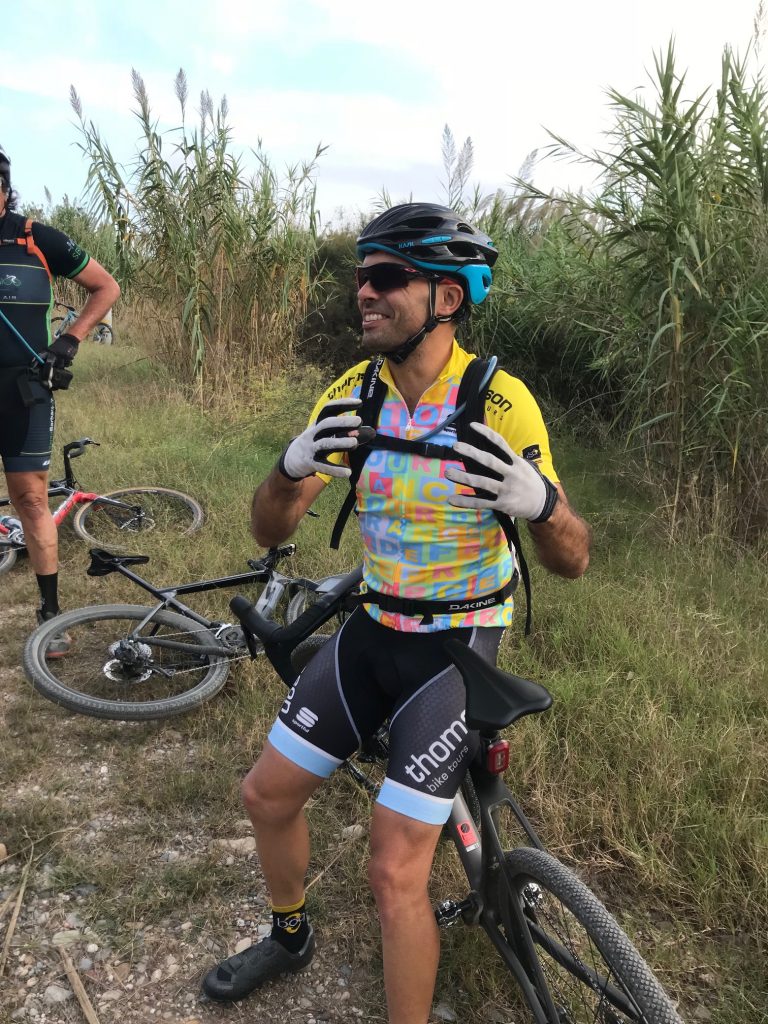
As it turned out, this was the first of many flats to come, with tubed wheelsets presenting most of the problems. My own Grail was set up tubeless, and I had no problems, at least until I looked down and saw a goathead on my front tire. I pulled it out, and the tiny hole started blowing air. I quickly put the thorn back into the hole, and the hissing stopped. At some point, it fell out on its own, and the sealant did its magic.
As we climbed up the river valley, we had a mix of hardpack, sand, roadbase, loose rock, shattered concrete, and more. One long section was heavily overgrown and had a narrow double track with many puddles. In the dry Spanish climate, it seemed like a lush jungle. After a quick lunch stop provided by our Queen of Snacks, Gisela, we started the climb to the famous monastery of Montserrat.
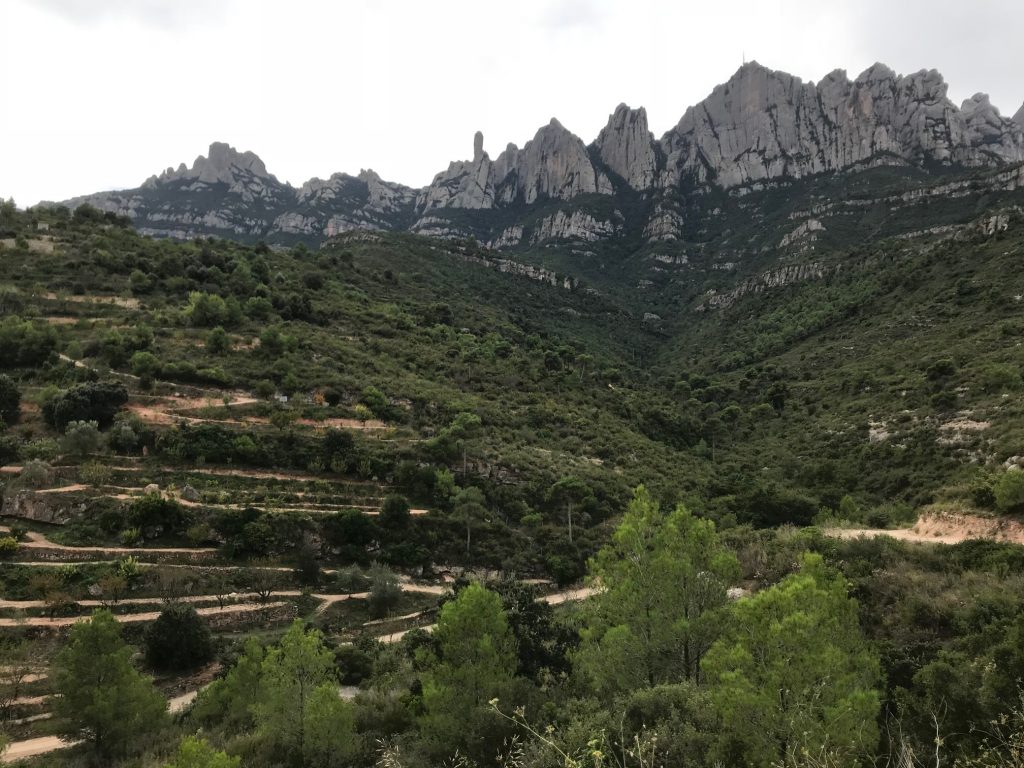
I rode with 2 other guests, at least until the road pitched up, then I rode alone. As I climbed dirt roads and through some small neighborhoods perched on the hillside, I soaked in the views. The mountain’s giant exposed knobs of granite are clearly a climber’s paradise, but from my vantage I could not see anyone climbing. I kept my eye on both my Garmin and its questionable GPS track, as well as to the dirt road, making sure I still saw bicycle tire tracks. Between the two, I maintained my progress upward, confident I was still headed in the right direction. I knew there were riders ahead of me and behind me, so I couldn’t run into problems.
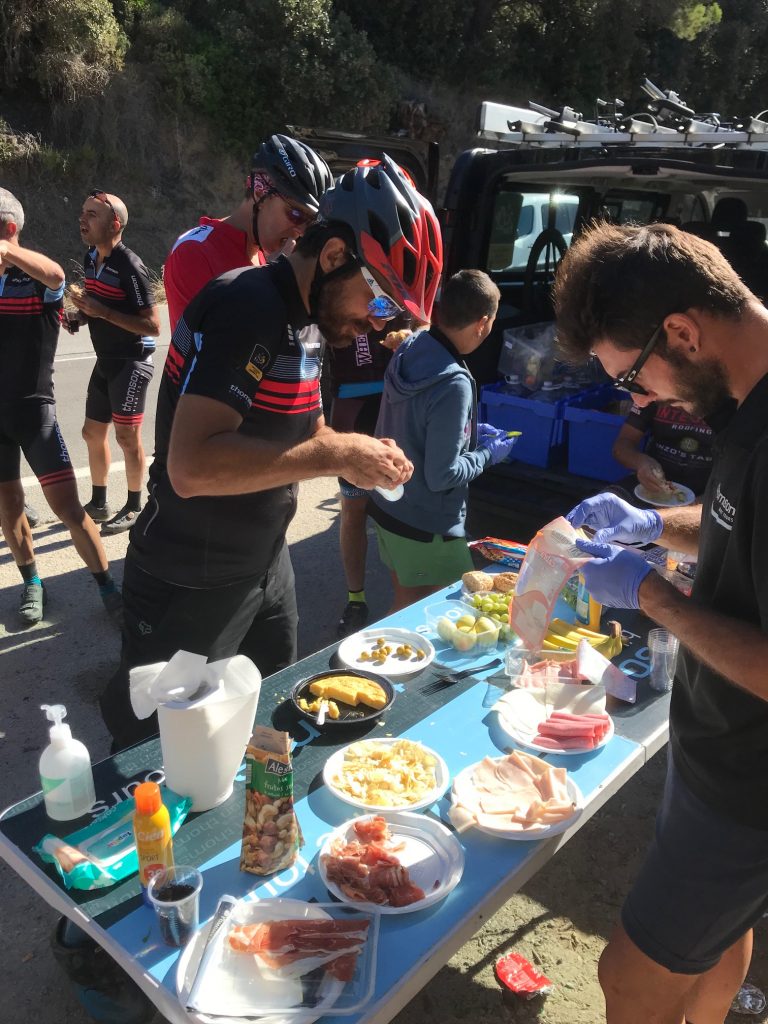
“No Cars”, the sign said. At least, that’s what I assumed the hand-painted (scrawled, really) letters read. The red circle with a white bar emphasized this, as did the electric fence and two small, homemade gate arms that crossed below the sign. Below it was a scrap of tarmac, and no visible bike tire prints. Off to the left, another dirt road swung away, and a small singletrack split the difference between the two roads.
In Colorado, not opening gates with hand-painted signs is usually considered a good initial step towards self-preservation, and I couldn’t see tire tracks on the other road, so I went for the singletrack. I rode for a few meters, following small bits of sand with tire tracks. The trail suddenly swung upwards over a rock outcropping, and I shouldered my bike. The tire tracks had mostly disappeared, but I could see fresh footprints in the sand.
The trail wound upwards, and I could see other roads, dirt tracks, and trails nearby. I kept climbing, on the general assumptions that 1) people had been coming to this mountain for thousands of years; 2) I could see enough roads and trails that eventually I’d cross something I could ride; and 3) it was not the first time I’d hiked with a bike. I ended up hiking about 2km before stepping onto a paved roadway. A hundred meters later, I came to the Thomson van, parked off the side of the road.
Another 2km of riding under giant granite outcrops, and I entered the parking lot. The second van was parked there, and the guides told me to keep riding to the top to see the monastery, then come back and change in order to explore on foot. I rode another km, but suddenly my rear tire started losing air, so I returned to the van. Exploring Montserrat on foot was pleasant, and the church was quite beautiful. However, after seeing Gaudi’s stained glass in Sagrada Familia work its magic, I doubt I’ll ever look at a rose window the same again. I then went in search of Basic Energy & Electrolyte Replacement, which I found at a small cafe near the main plaza.
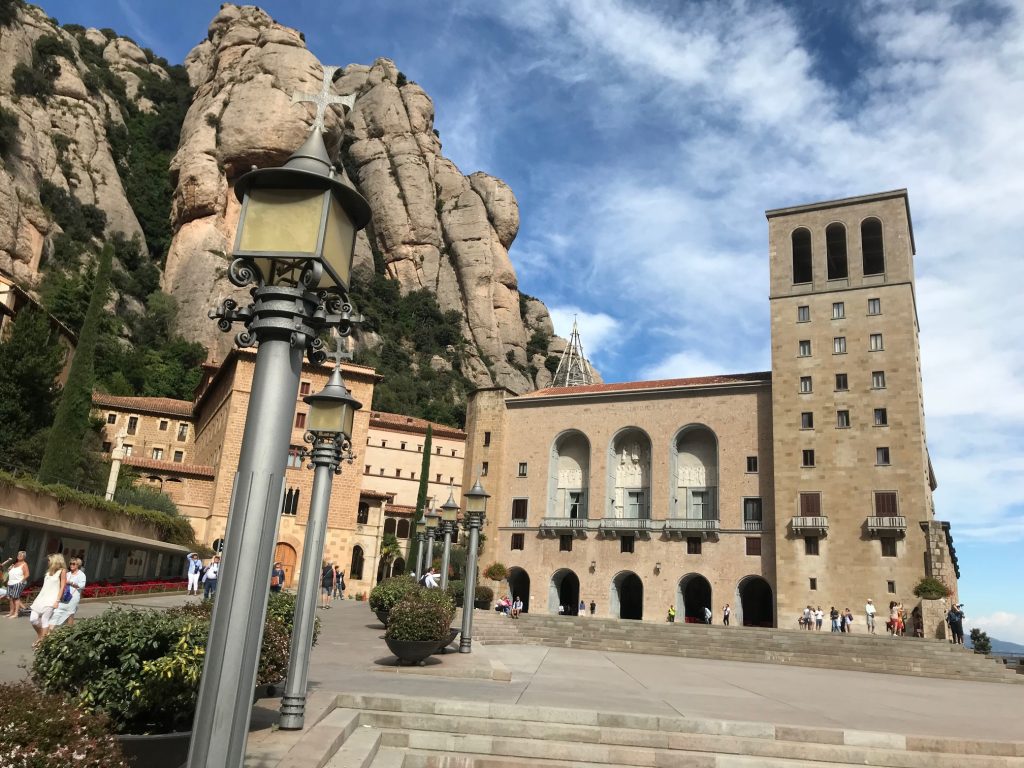
We took the vans back to the hotel, had a very thorough daily briefing, then dinner. This was the sole van transfer of the trip, a testament to the excellent planning and route design. Given the mixed terrain, varying gravel textures, and challenging ride, I was ready for bed. I was also ready to leave the hotel and Barcelona behind, as the adventure was kicking into high gear.
Actually, it was kicking into lower gears. The third day was big: 95km and 7500’ of climbing lay in store. I had managed to change some of the units in my Garmin, but not all. My distances were measured in kilometers, my elevation in feet. At least there were still 12 hours on my clock, that hadn’t gone metric. Given Garmin’s sometimes unstable firmware updates, though, it is not out of the realm of possibility.
We backtracked on the first day’s route, climbing back to the Collseroll trails and contour-lining for several km. As we headed eastbound along the ridge, I stole repeated glances over the city as the sun rose. We carried forward, dropping down to cross a larger paved road and river, then climbed again. And again. And again. The largest climb of the day was a long, straight section of dirt road that held sustained ramps over 20%. Fortunately, there were benches of 12% between the ramps. You know, for recovery.
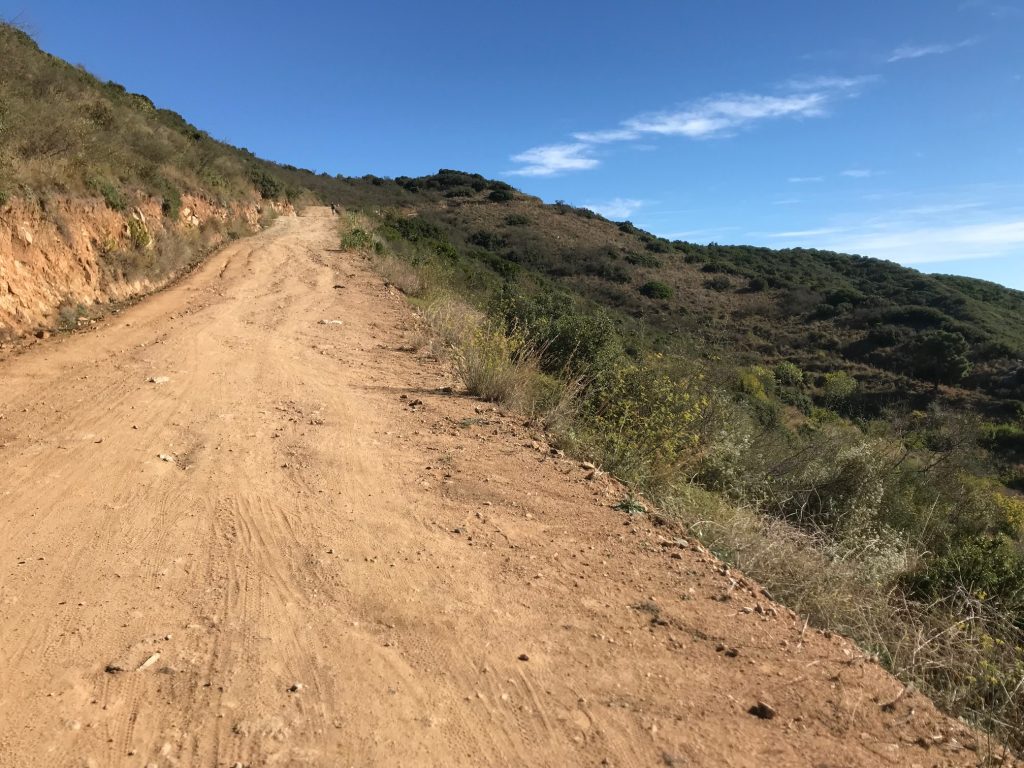
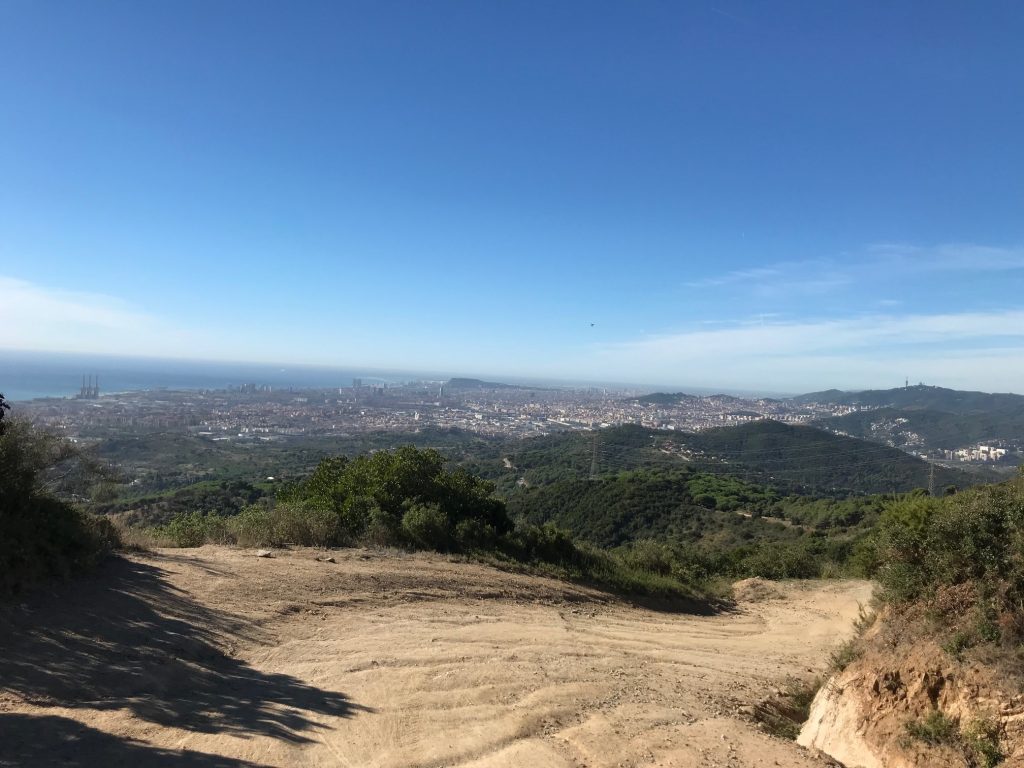
After cresting that big climb, we had many more miles of climbing and descending on a variety of surfaces, from hardpacked dirt to sand, doubles and singletrack, and many, many, many cross runnels on the dirt roads. Finally, we broke out onto pavement for the final climb before descending to our hotel. The climb itself was no huge challenge, with relatively low angle ramps and smooth pavement, but at the end of the day, it was a leg sapper. Once cresting, we were rewarded with a twisty, technical descent with loads of fun hairpins. Then it was a short ride to the hotel. I’d never climbed 7500’ and ended up at sea level before, and after a huge, delicious dinner, the sound of the waves crashing on the beach lulled me into a well-deserved sleep.
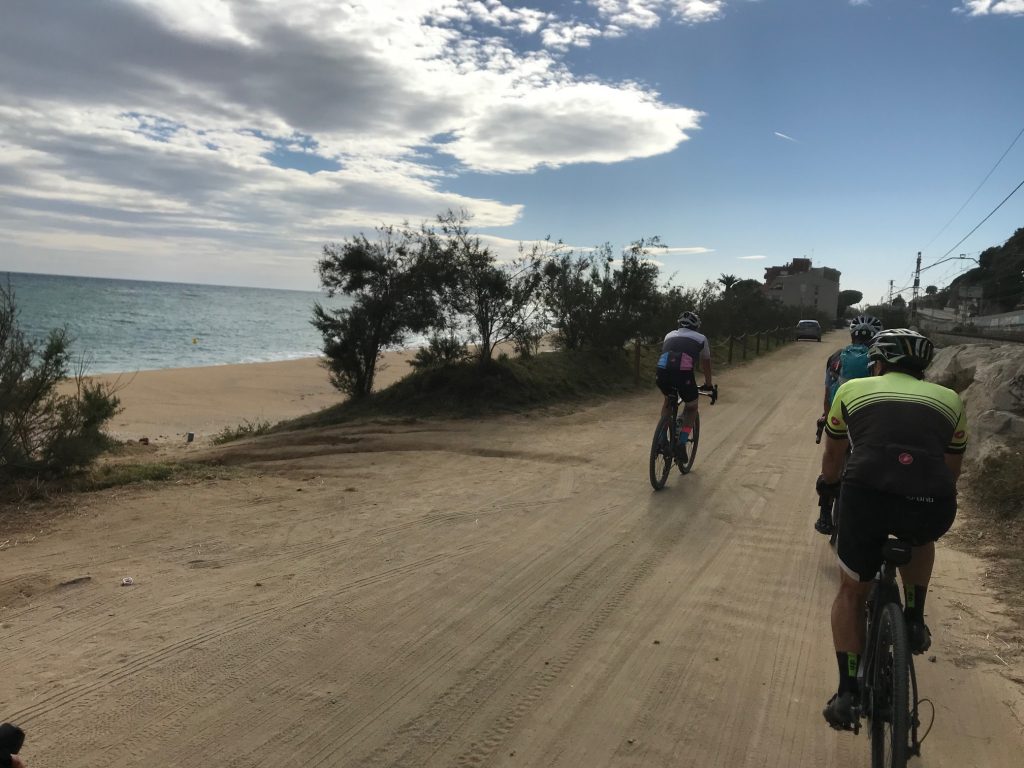
Day 4 promised climbing straight out of the gate. Our route would take us away from the coast, generally northeastward and again over the mountains. We climbed the previous day’s final descent, and I must admit, I liked it better as a descent. Once we turned away from the pavement, after about 12km, we hit a beautiful dirt climb, which meandered upwards through pine forests. Along this road was one of the steepest ramps of the trip, a deep slot cut straight through the hillside that exceeded 22%. My rear tire slipped on the loose sandy soil, causing me to walk the last 10 meters, but a few kms later, we descended down smooth-ish roads (with lots of water runnels) before ending up on butter-smooth dirt roads and rolling hills through farms to the hotel.
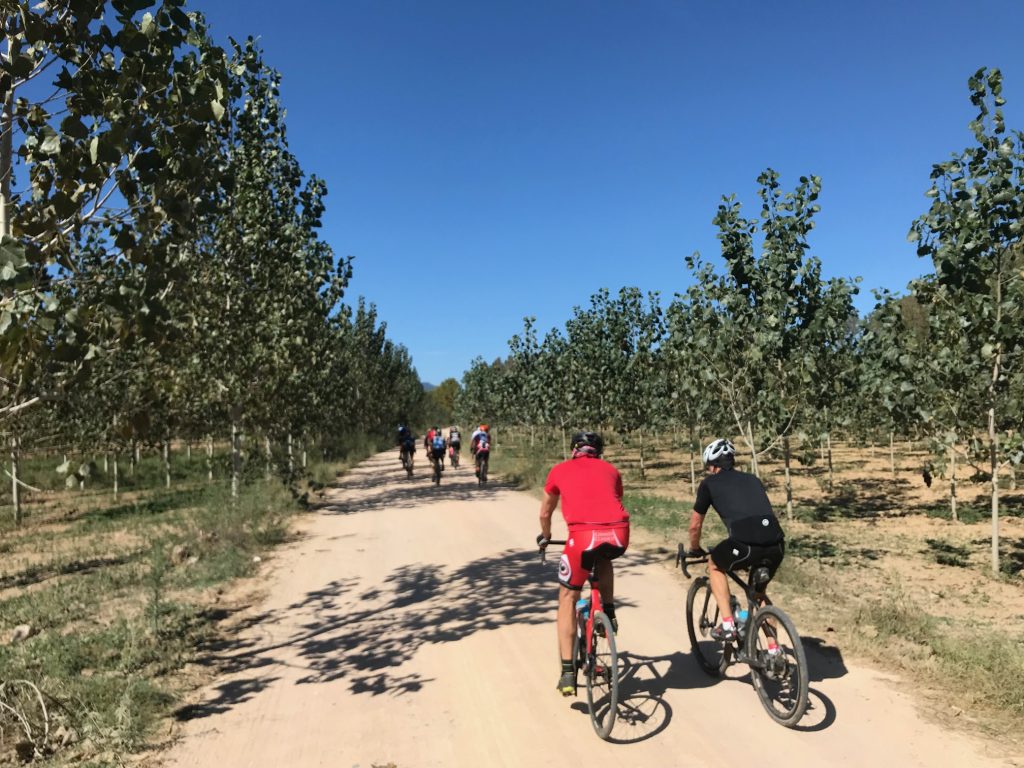
Tonight’s hotel was incongruous, located on the edge of a small town, not far from gas stations, car dealers, and construction suppliers. Town had the appearance and feel of a dilapidated truckstop crossed with a strip mall. In spite of this, the hotel was a beautiful resort, with golf courses, tennis courts, pools, a spa, and so forth. Even though today’s ride was much easier, the previous day’s climbing had sapped the tiny amount of power in my legs. I went for a leg massage, and it was both incredibly painful and incredibly good. With any luck, on tomorrow’s ride I would survive.
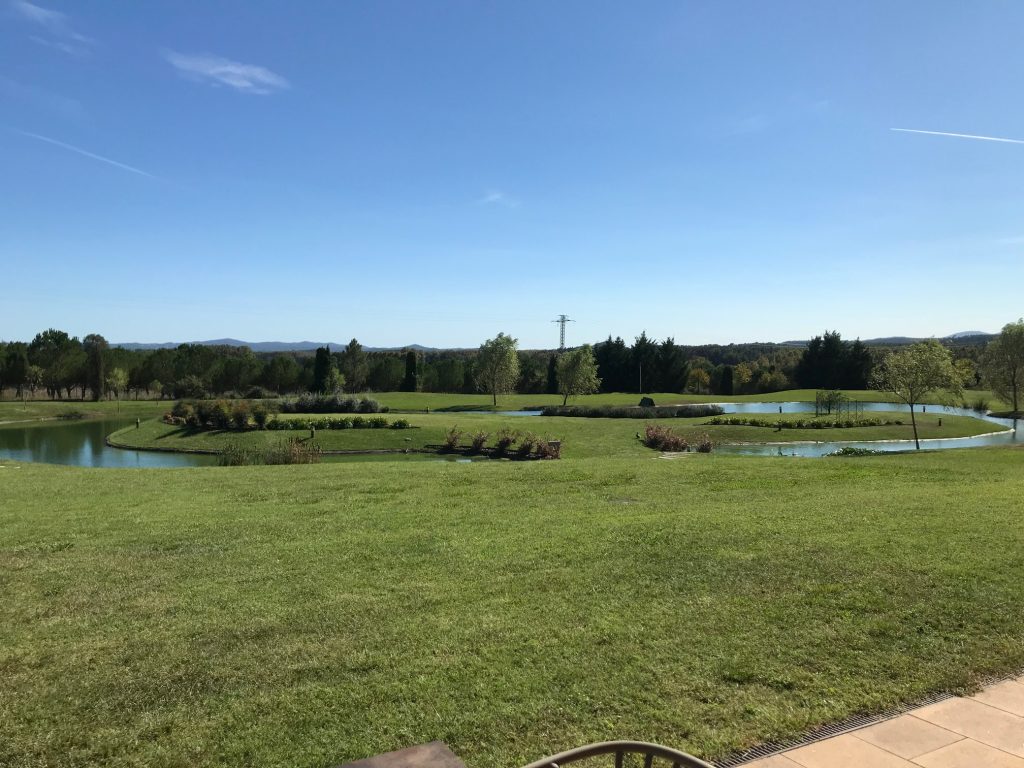
Day 5 promised quite a bit of climbing through spectacular scenery. We would loop northwards along a reservoir, finally climbing up through a small village and finishing at a stunning cliff-top hotel. I wasn’t sure how my legs were, but I slotted into the paceline as we rolled from the hotel. It was a bit faster than I wanted, particularly with no warmup, but I crossed my eyes and pressed on. As we entered the town of Angles, I realized I needed to stop at an atm, so I made a quick stop and grabbed some cash. The group kept charging forward, so I followed the gps track and climbed up above the first of 3 dams we would pass at Susqueheda. When I finally caught the van at the rest stop, I was told they’d only been waiting about 5 minutes, so clearly my legs were recovering from both day 3 and the massage.
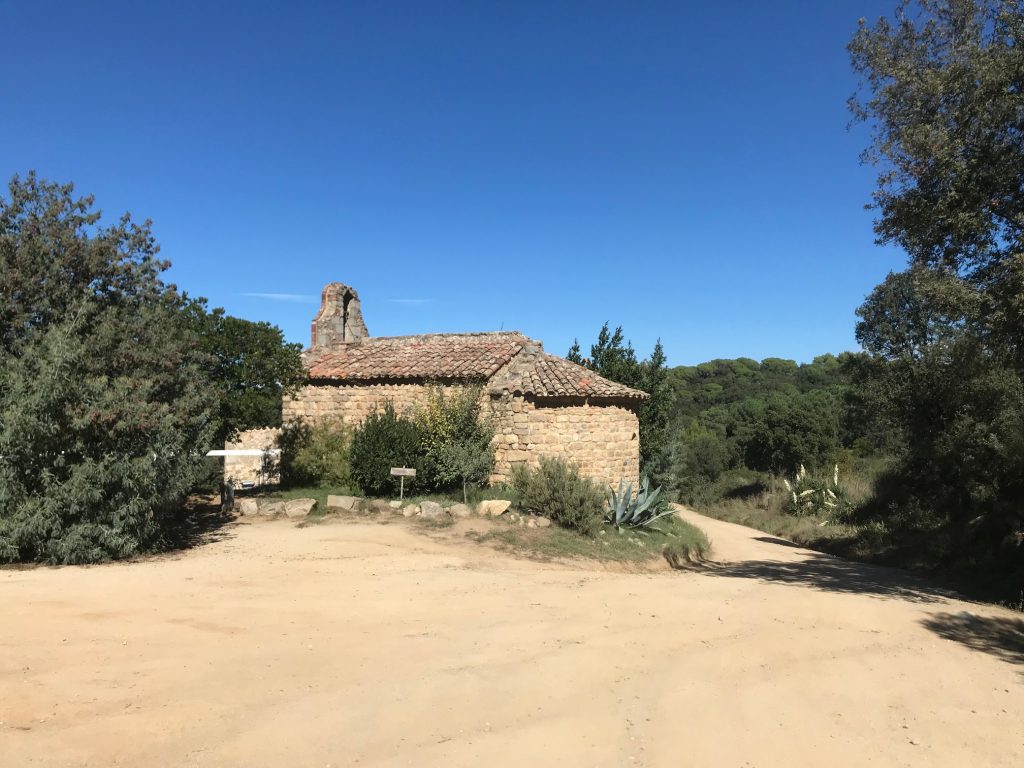
The paved road continued, with the guides describing a “false flat” for a little while. My gps showed switchbacks ahead, and it’s the first time I’ve heard a steady 9% grade labeled as a “false flat”. Before too long we got to the second dam, a large concrete structure that would make the WPA proud. A few minutes later and we were off pavement and back onto dirt. This double track varied between packed sand and chunky, square-edged rock gardens, and in some ways, was the most technical riding so far.
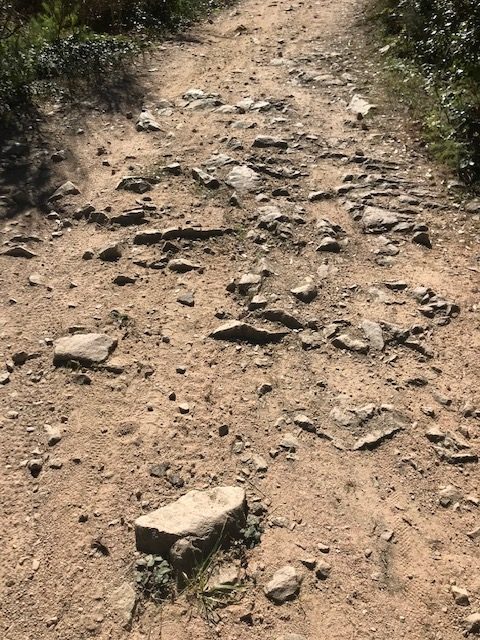
The road contoured above the lake, and gaps in the trees offered views to the water below. We were in a heavy forest, and the shade was a nice respite from the previous day’s hot sun. I realized I was starting to feel more of the rocks than I should, so I stopped to put air in my rear tire. I had burped it, and sealant was leaking along a few sports in the sidewall. Using my hand pump, I topped it off, crossed my fingers, and started up again.
After another kilometer, I had to stop again. Stop. Pump. Repeat. One of the guides gave me a tube, and I pressed forward, knowing the mess that would ensue as soon as I broke the tire bead away from the rim. Stop. Pump. Ride. Repeat. After another 3km, that was it- I admitted defeat and stopped.
My own (non-existent) gravel bike and road bike are tubeless, and I am well familiar with how tight the tires can be. I was pretty surprised at how easily I unseated the Schwalbe G-One Bite tire from the rim. I was also surprised, but not in a good way, to discover that the tube I had been given had a 33mm stem. 33mm stems are common, having been the default size for generations. However, today’s road rims are often deeper, up to 80mm. This particular rimset was 30mm deep, so although I had no problems putting the tube in, my pump would not work as there wasn’t enough stem for it to grab.
The tube was in, but there was no way I could air it up.
I resigned myself to walking, so onward I trudged, for about 6km. Despite the forced march, the forest was cool, the sky was a beautiful pure blue, and the views of the lake were amazing. At one point, I could see the cliff top where our hotel waited. Eventually, the guide came back, looking for me. I explained the tube problem, and we ended up checking every tube in his pack. One worked, it had a 35mm stem, and using a Presta-Schraeder adapter, we were able to get enough purchase with the pump. I was back in business.
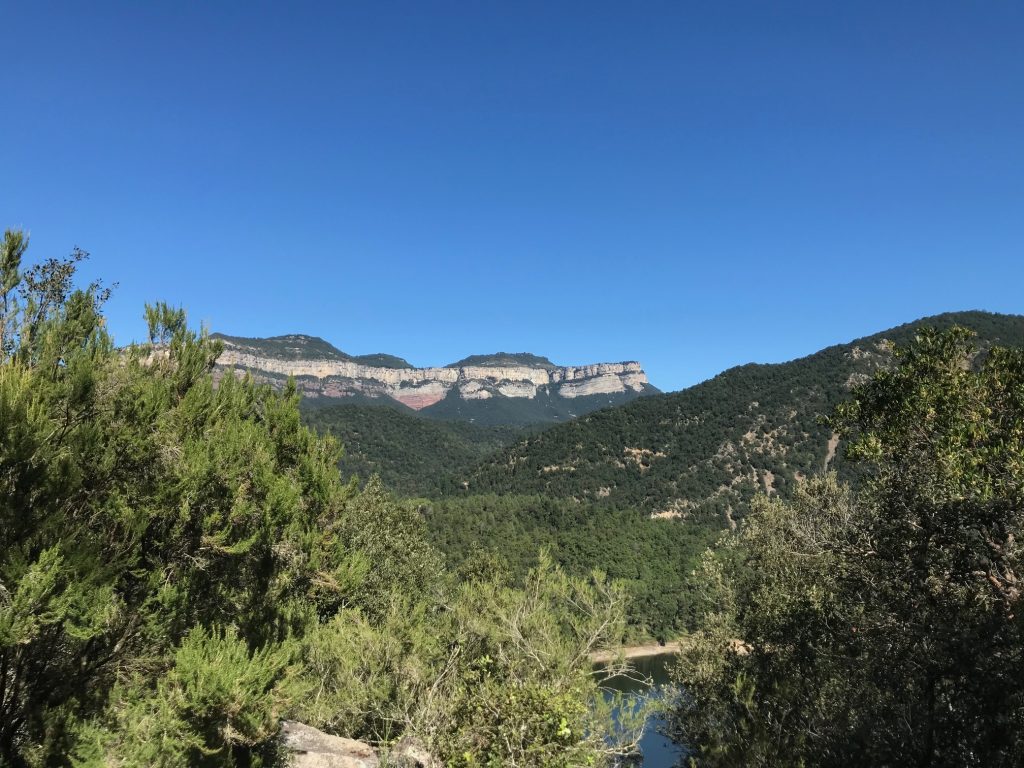
The remaining 2 or 3 km to the van was easy, and seemed fast after so much trudging. The group was long gone, so after a quick snack, it was back on the bike. This climb was stepped, with short steep ramps and flat recovery sections. The road followed the geology, with steep ramps cut across cliff bands. Groves of trees and farm fields dotted the hillside. We emerged into a small village and found the van waiting for us, with a few slices of bread and some cold cuts, and most importantly, Cokes. A quick refuel and we were soon on our way, pushing to the last climb of the day.
Earlier, we had been able to look up to the hotel from the lakeside road. At the time, it seemed lower than I had expected, and to be honest, so far the climbing hadn’t been too difficult. There was one big ramp left, though, and as we rounded a corner, it lay there before us: a concrete road cutting up through the forest at a maintained 24%. The concrete surface was steep enough that the builders had scored it for for traction.
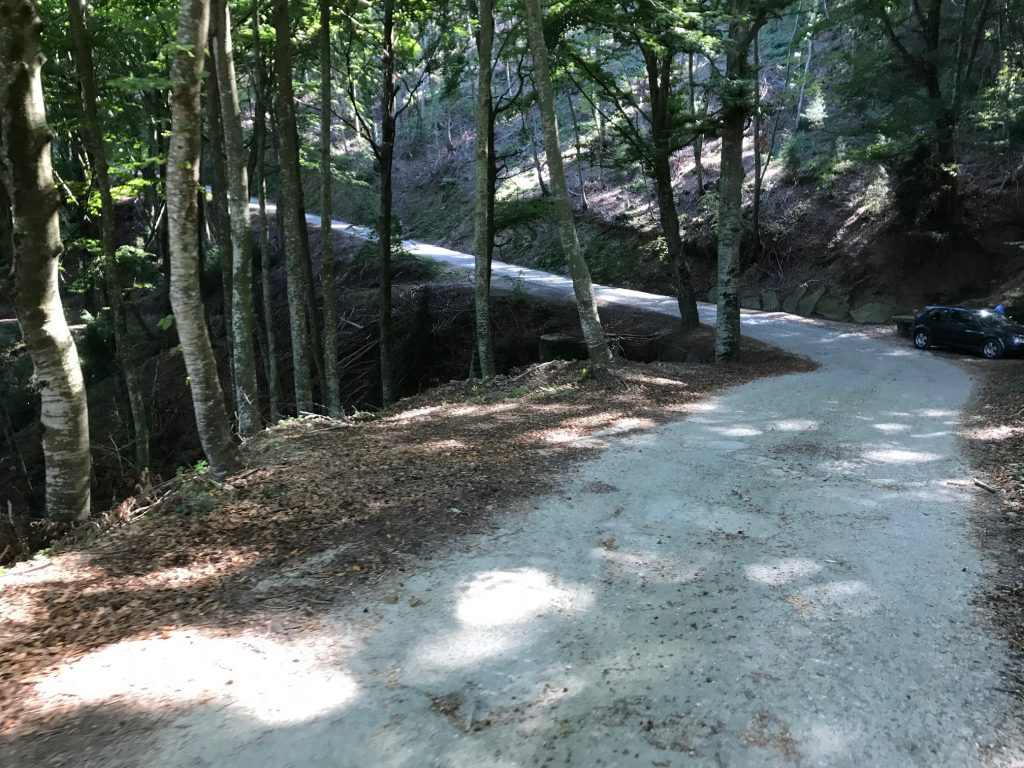
There had been much discussion of Spanish Concrete, and suffice to say, it has a texture all it’s own. Generally coarse, often with drain grooves, and rough patches. When I say “rough patches”, that’s being generous. It seems the technique used is to mix the concrete in a bucket (or in the hole), dump it in, swirl it once, and leave. Using trowels or floats is strongly discouraged, as the apparent goal is to emulate Hawaiian lava. The pointy stuff, not the ropy stuff.
Once we broke out from the forest, the views were stunning, with eagles riding thermals and glimpses of the Pyrenees in the distance. To the east, in the valley bottom, we could see Girona, tomorrow’s destination.
The hotel, L’Avenc, was simply amazing. Perched on top of the cliffs, it offers huge vistas and vast silence. Even though we nearly filled the place with our group, and everyone sat on their room verandas enjoying the afternoon sun, it was quiet enough for me to hear air rushing through a crow’s feathers as it flew overhead.
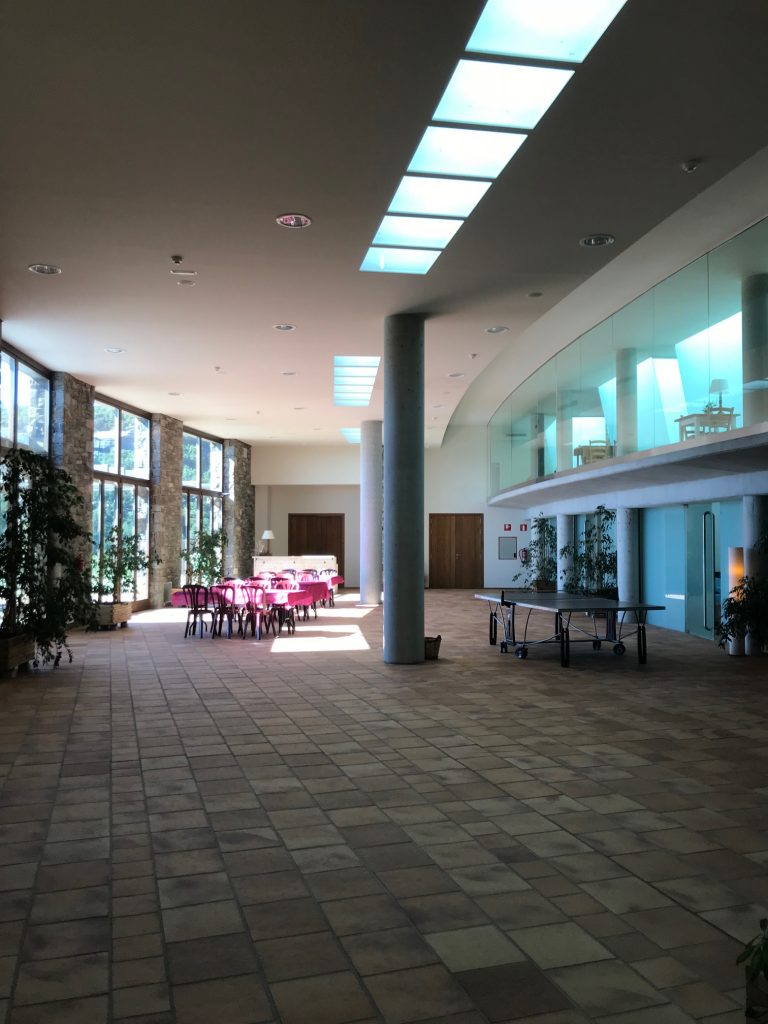
The hotel is a work in progress, having started as a centuries-old farmhouse that served as the seed of the facility. It features a ginormous underground garage worthy of a Bond villain, complete with glass elevator to the main floor. Once inside, the daylighting design is impressive, with deep sunbeams reaching into the space, clever skylight wells delivering natural light to interior rooms, and open, airy guest rooms with private patios. Real wood floors (with expansion joints filled with sisal rope), comfy chairs and an ample beer fridge(!) greet you on the mezzanine level. Atop the garage is a large flat expanse of grass that features 4 chairs perched at the edge of the drop off. They beg you to sit in them and enjoy the view, which I did, after visiting the fridge.
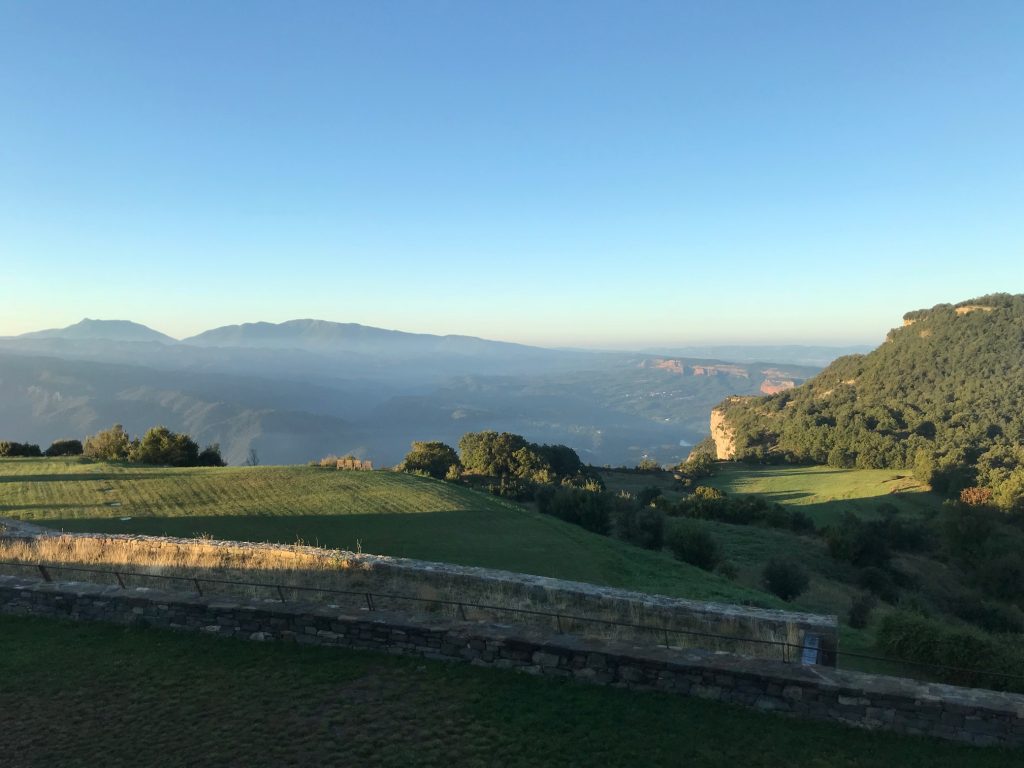
I’ve stayed in lots of hotels, but none like this. It’s absolutely gorgeous, and on its own, is worth the journey to Spain. Visit the website, read the history, make a reservation.
After an amazing dinner, complete with nettle soup and black rice, we had our nightly briefing. As usual, Thomson’s attention to detail was impressive, and every inch, uh, centimeter of the final day’s ride were discussed. We would roll across the plateau, through farms and small hills, before an extremely steep, somewhat technical descent down a broken concrete road. From there, we would turn towards Girona, following an unpaved rails-to-trails network.
The sun rose on our last day, and we looked over the cliff edges at the dissipating fog in the valleys below. To the north, the Pyrenees loomed, close, but for this trip, tantalizingly out of reach. We lingered along the cliffs, soaking in the warming sun and removing layers, knowing that although today was mostly downhill, we still had 1800’ to climb in the first 20km or so.
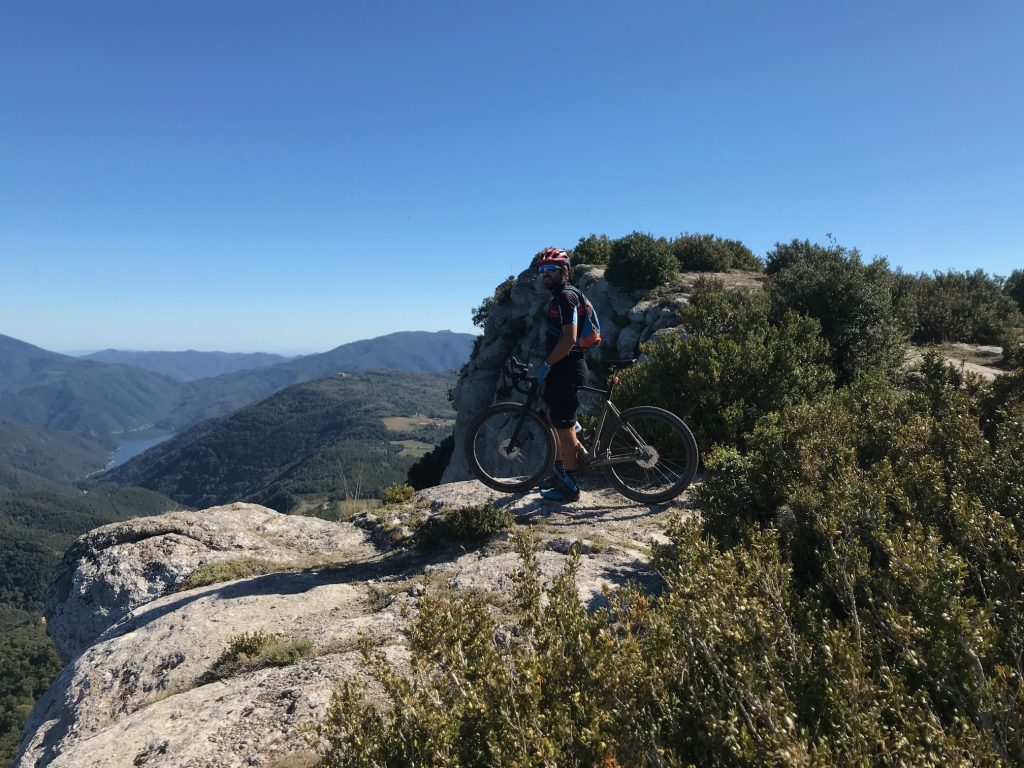
Once off the upper cliffbands and on to paved roads, we settled into a brisk paceline. We hit a long 6% grade, and not wanting to challenge anyone’s expectations, I drifted to the back as normal. I climbed at my own pace, as usual, and watched as a few snails passed me on the left. They were too low for me to draft off, and they too disappeared in the distance.
The farm country that rolled by offered short, steep climbs and descents on narrow but remarkably smooth roads. Each vista that opened in gaps through the trees was backdropped by the Pyrenees, and every corner offered a chamber-of-commerce brochure photo view. I would have been quite happy spending the day exploring the area we crossed, there is little doubt that we didn’t scratch the surface of the available cycling.
The aforementioned descent was indeed long and challenging, and we went on about 1-minute intervals. This was definitely one for disc brakes, with uncounted switchbacks, grooved and broken concrete surfaces, and grades rarely below 12%. It twisted down the cliff face, through a deep forest, and dappled sunlight masked many deep craters in the road. I was quite delighted to be descending it instead of climbing.
At the bottom, we regrouped, wound through a small town, and picked up the rail bed that would lead us to Girona. This had once been a major rail network, and old concrete platforms dotted the route. Larger stations had been converted to cafes, and we stopped at one for a lovely morning espresso. The group seemed to be trying to stretch this last day, savoring the flat grade and denying the inevitable end of the trip.
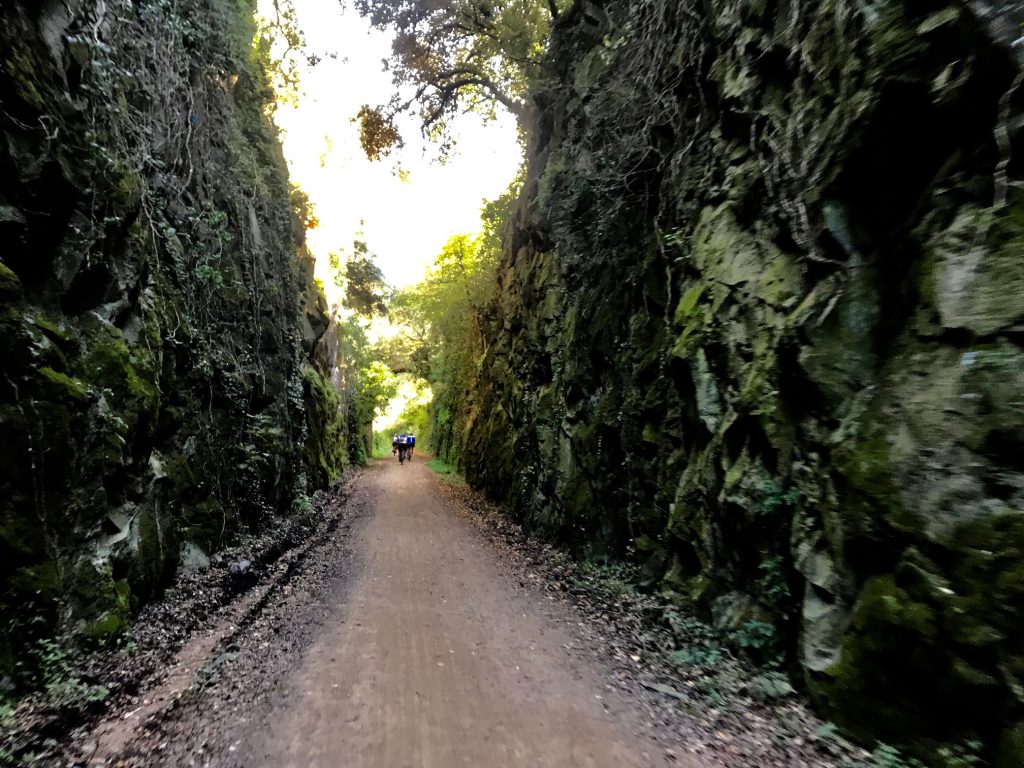
We remounted and headed down the path, and this is where the espresso suddenly kicked in. Perhaps the guides could see they were nearly done, perhaps the 1% descent required it, but we were now in a 15-person gravel team time trial. The pace was very high as we hammered down the packed course-sand surface, blowing past cafes and other normally-enticing stops. Even lunch at the van seemed rushed, and after wolfing down small sandwiches, we were back on the bikes. For once, instead of lollygagging at the back of the pack, I clung to the lead guide’s wheel as he charged towards Girona.
Until I flatted. My rear tube, which had survived pretty well over rocks and broken concrete, gave up on smooth packed sand. A quick change and I chased back to the pack on the outskirts of Girona. As with most cities, the perimeter is far from scenic, ranging from agricultural to industrial, but before long we entered a huge city park and worked our way towards the old city. As we rolled through, suddenly surrounded by urban traffic and small, twisty roads, we got glimpses of ancient buildings and the many bridges crossing the river. A short, very sharp climb up the eastern side of town, and we were at our final hotel.
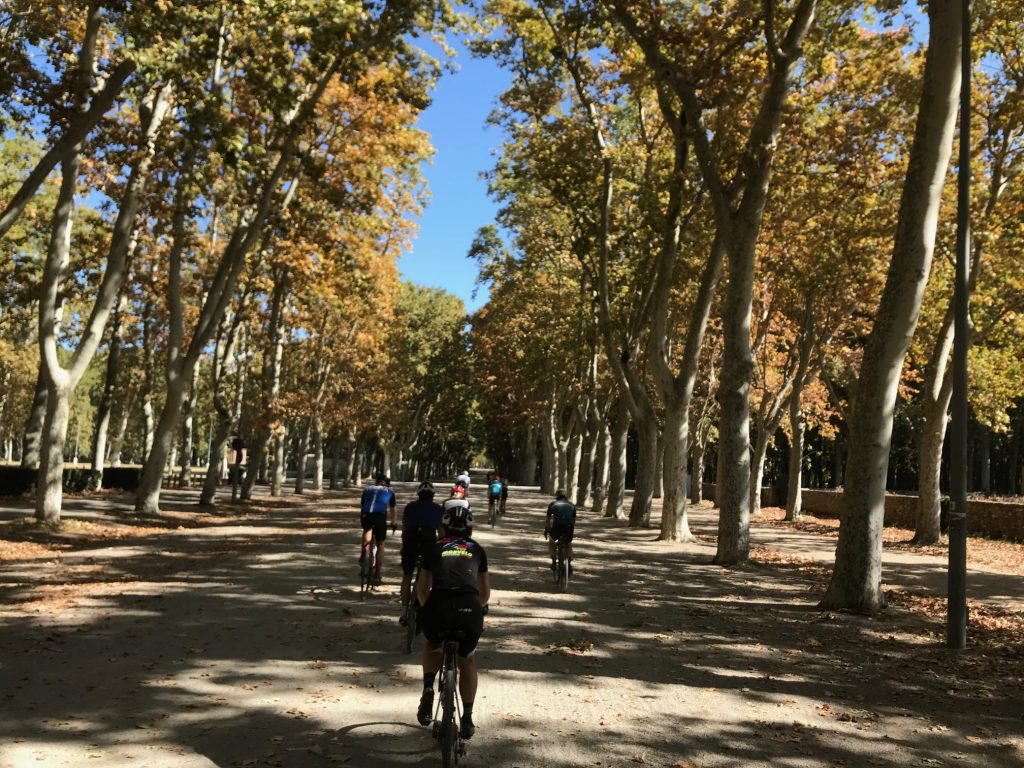
Our pace along the rail paths had been brisk enough that we were early and our rooms weren’t ready, so naturally I ordered a large beer at the lobby bar and sat down to savor the trip, rolling our adventures around in my skull as I swirled the beer around my mouth. There was so much to consider, I needed another beer.
Girona itself is a thoroughly enjoyable small city, and I stayed for 3 days to do more cycling exploration. Some of the other guests on the trip also stayed, and we checked out some of the best that the area had to offer. It quickly became abundantly clear that it would take many more visits to really get to know the cycling that Girona has become known for.
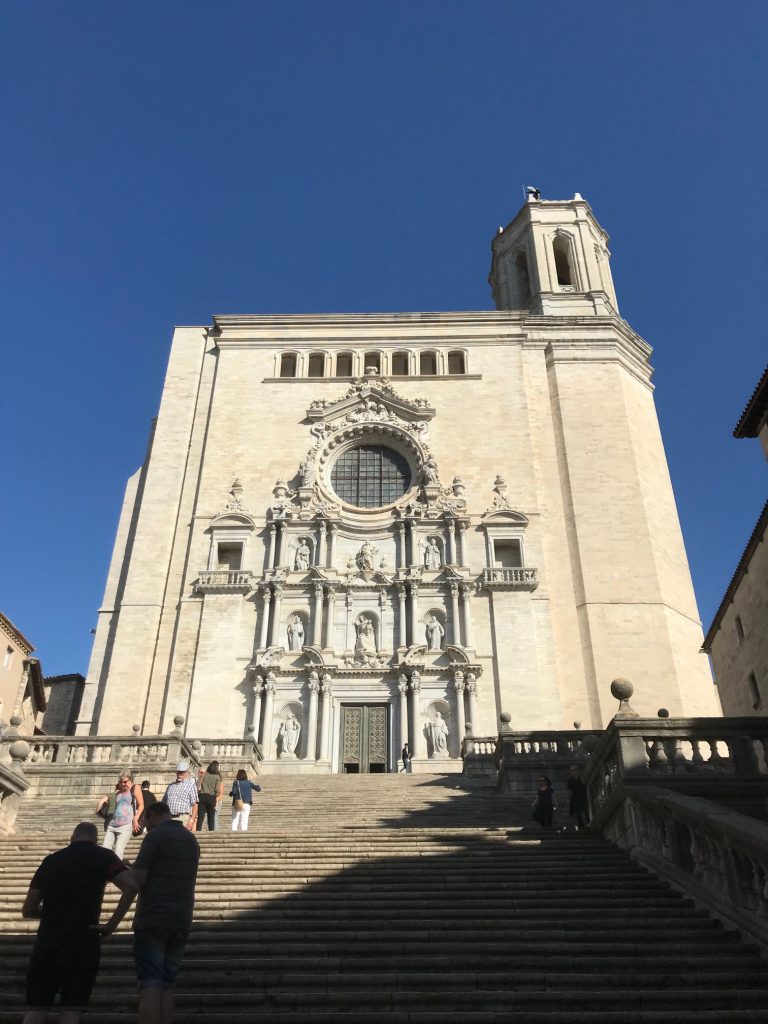
The trip was excellent, particularly due to the hard efforts of the Thomson staff and their route-finding. Clearly, a huge amount of local knowledge was required to craft these routes, and they were still being refined up until the very last minute. The guides told me they had based the trip design on American gravel preferences, specifically Dirty Kanzaa and Grinduro. Although these are marquee events in the gravel scene, I’m not convinced they are the standard bearers for gravel in the USA.
Perhaps my definition of gravel riding is different, or more likely, there is no definition. Generally, I think gravel means getting off the beaten tarmac, onto smaller, out-of-the-way roads and trails. It means avoiding cars, finding less-frequented routes, slowing down a bit, and savoring the views. If the Thomson trip is graded on these criteria, it was a smashing success, particularly for a first effort and with a bunch of cyclists who all carried their own gravel definitions and expectations.
The challenge of creating a trip with well-designed routes, feed stops and menus, hotels and restaurants, and all the logistics to join them together should never be underestimated or taken for granted by a guest. Delivering this and making it look easy is a testament to the skills and talent of Thomson Bike Tours, and justifies every cent of the cost of the trip. Thomson showed why they are one of the top touring companies in the world, and I keep finding myself back on their website, browsing for further adventures.
I’ve worked for river guides, paid my dues as a private instructor at an exclusive ski resort, and have helped create cycling trips with and for friends. I can speak firsthand to how hard it can be to create a superior guest experience, and to how easily things can go sideways. Thomson avoided the pitfalls and showed their professionalism every minute of the trip. Kudos to their team, and thanks for the trip of a lifetime.
